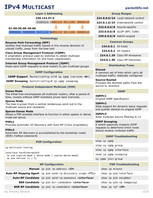In computer networking, multicast (one-to-many or many-to-many distribution) is group communication where information is addressed to a group of destination computers simultaneously. Multicast should not be confused with physical layer point-to-multipoint communication.
Group communication may either be application layer multicast or network assisted multicast, where the latter makes it possible for the source to efficiently send to the group in a single transmission. Copies are automatically created in other network elements, such as routers, switches and cellular network base stations, but only to network segments that currently contain members of the group.
Network assisted multicast may be implemented at the Internet layer using IP multicast, which is often employed in Internet Protocol (IP) applications of streaming media, such as Internet television scheduled content (but not media-on-demand) and multipoint videoconferencing, but also for ghost distribution of backup disk images to multiple computers simultaneously. In IP multicast the implementation of the multicast concept occurs at the IP routing level, where routers create optimal distribution paths for datagrams sent to a multicast destination address.
Network assisted multicast may also be implemented at the Data Link Layer using one-to-many addressing and switching such as Ethernet multicast addressing, Asynchronous Transfer Mode (ATM) point-to-multipoint virtual circuits (P2MP) or Infiniband multicast.

